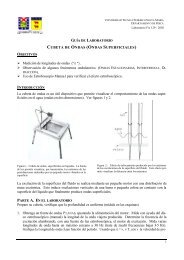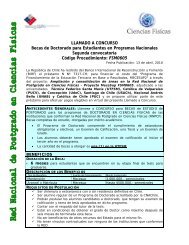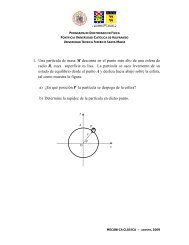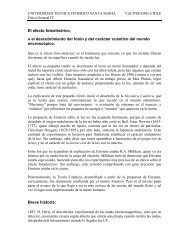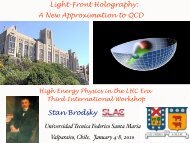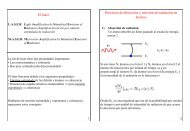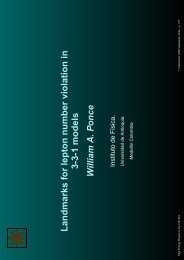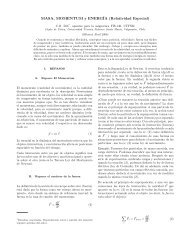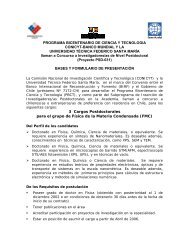Aca - Departamento de Física - Universidad Técnica Federico Santa ...
Aca - Departamento de Física - Universidad Técnica Federico Santa ...
Aca - Departamento de Física - Universidad Técnica Federico Santa ...
Create successful ePaper yourself
Turn your PDF publications into a flip-book with our unique Google optimized e-Paper software.
V Encuentro Sud Americano <strong>de</strong> Colisiones Inelásticas en la Materia<br />
dP/dϕ f<br />
(arb. u.)<br />
N→Ag(111)<br />
-0,006 -0,004 -0,002 0,000 0,002 0,004 0,006<br />
Azimuthal angle ϕ f<br />
(rad)<br />
Figure 1. Azimuthal angular distribution of<br />
elastically scattered projectiles for 3 keV N atoms<br />
impinging on Ag(111) along the direction<br />
-1,-1,2, with a glancing angle ( θ i =0.4678<br />
<strong>de</strong>g.)<br />
dP/dΘ (arb. u.)<br />
N→Ag(111)<br />
E i ⊥<br />
= 0.2 eV<br />
-1.6 -1.2 -0.8 -0.4 0.0 0.4 0.8 1.2 1.6<br />
Deflection angle Θ (rad)<br />
Figure 2. Angular projectile distributions, as<br />
function of the <strong>de</strong>flection angle Θ, for N atoms<br />
scattered from Ag(111) along the direction<br />
, with E i = 0.2 eV for the inci<strong>de</strong>nce<br />
energy E i = 3.0 keV.<br />
Angular distributions of N atoms scattered<br />
from the Ag(111) surface display diffraction<br />
patterns that <strong>de</strong>pend on the axial inci<strong>de</strong>nce direction.<br />
For scattering along the channel,<br />
the angular spectrum presents interference structures,<br />
with peaks symmetrically placed with respect<br />
to the inci<strong>de</strong>nce direction. The complexity<br />
of these structures augments dramatically as E i<br />
increases up to 1.0 eV, indicating that the scattering<br />
of N atoms from a Ag surface tends to<br />
blur interference patterns more easily than for<br />
helium impact.<br />
Something similar happens when we consi<strong>de</strong>r<br />
the wi<strong>de</strong>r channel , which displays an<br />
even stronger corrugation. In addition, this inci<strong>de</strong>nce<br />
direction does not run along a symmetry<br />
axis of the surface, and this results in angular<br />
distributions displaying asymmetric structures<br />
with respect to φ f =0. Therefore, the high reactivity<br />
of N atoms favors the sensitivity of diffraction<br />
patterns to asymmetries across the<br />
channel, which in this case are originated from<br />
the contributions of target atoms from the second<br />
layer below the topmost atomic plane.<br />
We have also analyzed the contribution of<br />
inelastic processes. Our results suggest that they<br />
might not be so important as expected in the<br />
consi<strong>de</strong>red energy range, which is in accord with<br />
available experimental results. Given its high<br />
resolution in energy, diffraction of fast atoms<br />
from surfaces may therefore become a useful<br />
quality check for both insulating and metallic<br />
PESs, also providing a promising tool for surface<br />
analysis.<br />
References<br />
[1] A. Schüller et al., Phys. Rev. Lett. 98,<br />
016103 (2007); P. Rousseau et al., Phys.<br />
Rev. Lett. 98, 016104 (2007).<br />
[2] N. Bundaleski et al., Phys. Rev. Lett. 101,<br />
177601 (2008).<br />
[3] M. Busch et al., Surf. Sci. 603, L23 (2009).<br />
[4] M.S. Gravielle et al., Phys. Rev. A. 78,<br />
022901 (2008).<br />
[5] G. Kreese and J. Hafner, Phys. Rev B 47,<br />
558 (1993).<br />
[6] H.F. Busnengo et al., J. Chem. Phys. 112,<br />
7641 (2000)<br />
[2] J. B. Good, Technical Writing for Dummies<br />
(Wiley, New York, 1923).<br />
33 Valparaíso, Chile



